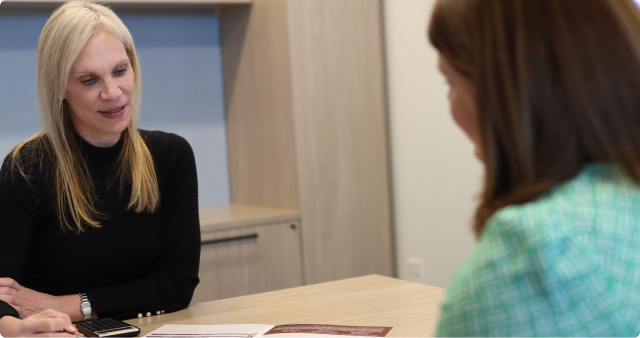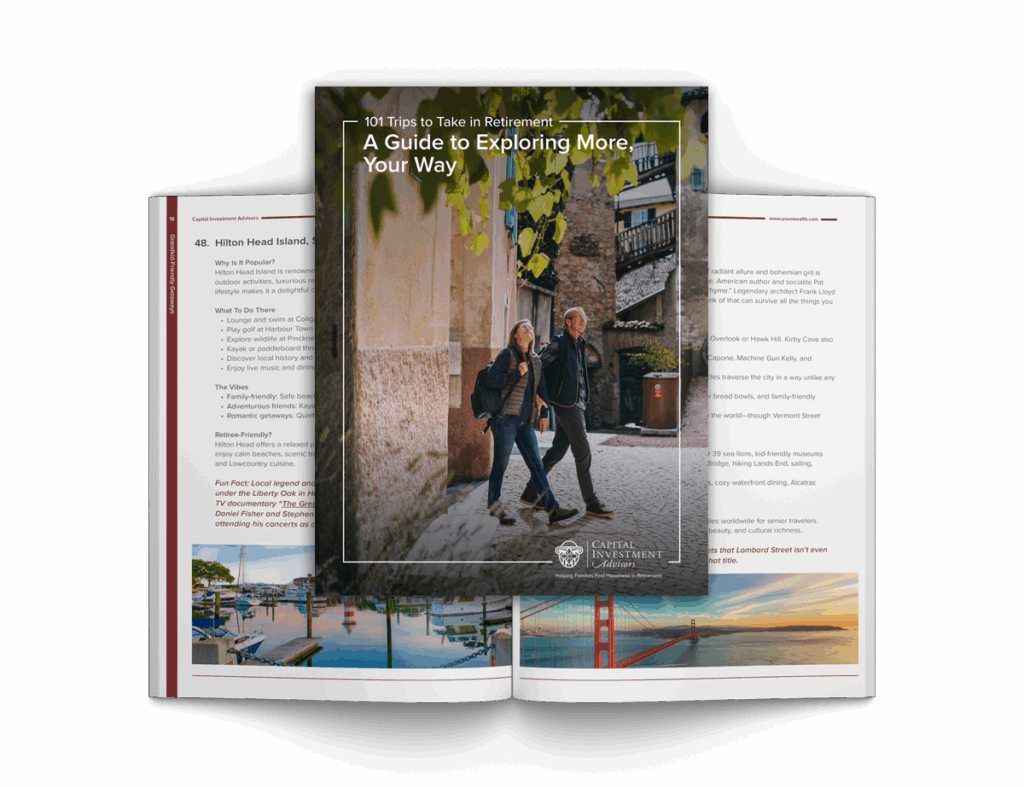Tackle Roth IRA strategies, dollar cost averaging, passive investing risks, strategic retirement withdrawals, and more. Whether you’re planning early retirement or optimizing your current portfolio, Wes and Christa deliver actionable insights and answer listener questions, including:
-
Is Passive Investing Creating a Bubble?
Are index funds inflating markets? Or do global diversification and ongoing price discovery demonstrate otherwise? Is it a mistake to dismiss all active strategies? -
Roth IRA Allocation
Roth IRAs often have the longest time horizon. Does that make them ideal for more aggressive, all-stock index fund investing? -
How to Diversify an IRA After a Rollover
Is it helpful to go beyond S&P 500 funds with mid- and small-caps? Treasuries? Corporates? REITs? Commodities? Energy pipeline investments? -
Avoid Paying Roth Conversion Taxes from a Roth?
Does it reduce long-term value to use Roth funds to pay taxes on a conversion? Is it okay to spread conversions over several years? -
What Is Dollar Cost Averaging (DCA)?
DCA can help reduce timing risk by investing consistently over time. Is it beneficial for large cash amounts and emotional ease? -
Investing a Lump Sum? What About a 50/50 Split?
Should you consider investing half up front and dollar cost averaging the rest over several months for balanced risk and reward? -
Effective Withdrawal Strategy in Retirement
Is it more strategic to pull from bonds/cash rather than stocks in down markets? -
Should You Use Target Date Funds?
They can be handy early in your career, but do some get too conservative by retirement age? -
Is the Reverse Glide Path Worth It?
Starting conservative and getting more aggressive later may look good on paper, but does its complexity overshoot its practicality in real life?
🎧 Tune in now to hear stories, stats, and effective financial planning that could reshape your future. Subscribe, share it with a friend, and take one step closer to your happy retirement. Follow the show on Instagram and YouTube.
Call 800-805-6301 to leave a voicemail or contact us HERE for a chance to have your question featured in an upcoming episode.
Read The Full Transcript From This Episode
(click below to expand and read the full interview)
- Wes Moss [00:00:04]:
I’m Wes Moss. The prevailing thought in America is that you’ll never have enough money and it’s almost impossible to retire early. Actually, I think the opposite is true. For more than 20 years, I’ve been researching, studying and advising American families, including those who started late, on how to retire sooner and happier. Now I’m bringing in my good friend Christa Dibias, who has worked closely with Clark Howard for many years now to answer, answer your questions and explore what makes a happy and fulfilling retirement. My mission on the Retire Sooner podcast is to help a million people retire earlier while enjoying the adventure along the way. I’d love for you to be one of them. Let’s get started.Wes Moss [00:00:51]:
Wes Moss along in studio with Christa DiBiase. Christa hi Wes.Christa DiBiase [00:00:57]:
So what are you going to talk about today?Wes Moss [00:00:58]:
You know, this is some of this is sparked by the questions that I’ve been getting, not only through the families I work with, but from you, from our listeners. And the first topic has to do with passive investing. So index based investing, is that in itself because it’s become so popular, is that creating a bubble, a stock bubble that could be bad? So we’ll talk about that. And also inspired by some of the questions we’ve had from our listeners and viewers, I wanted to dive into dollar cost averaging and talk about kind of some of the fundamentals around that today. All right, so let’s jump into this passive bubble. The other thing is that I’ve read, I’ve had folks send me some articles around this and they were the New York Times did a big article about this. Harper’s did a big article around this. And then there’s lots of other you start searching, you Google a passive bubble and you can find a lot around this.Wes Moss [00:01:53]:
And so first of all, when I say passive, we mean index funds. And I know that Clark’s been talking about them for years. Oh, yes, John Bogle from Vanguard really was the pioneer and started index fund investing back in the 1970s. In the very early years, there was a lot of pushback. Well, why would you ever want to just do what the market does when all of these other mutual fund managers trying to beat the market? And then ultimately what happened is that there it became somewhat or commonly understood that a lot of times active managers don’t beat their benchmarks. And that kind of that cadence and that thought became more and more widely known and accepted. A lot of it is just because passive funds are so inexpensive. And if you look at that ULTRA Low cost versus an active manager, that is racking up 1% or 2 or 3% charges every year.Wes Moss [00:02:46]:
It kind of makes it so that it’s easier for passive funds to win. So it started out as this nascent idea, kind of crazy idea. Then it becomes, became somewhat accepted. Then I’d say more, maybe even more recently, it’s become almost the default. And one of the worries is that, and just this past year, according to Morningstar, we saw for the first time more money flow into passive index funds than we did active. And that’s when you started seeing this drumbeat of wait a minute, maybe there’s just too much in passive. What could be the problem? Well, remember, and we’ve had some questions around this, most indexes are cap weighted so that the top 10 companies are making up because they’re so massive. Multi, multitrillion dollar companies, they have a very outsized share of what the market does.Wes Moss [00:03:42]:
So goes the biggest 10 companies, so goes the whole 500. And the worry here also is with so many people putting money in these cap weighted indexes, is it driving the prices of those companies up? And I think that would be the case if you look at, sometimes I’ll look at these problems and I’ll look at them in extremes, right. If we had no, if everything was passive, then I could see that being a problem because you’d have no price discovery. Everyone was just blinding, putting money into the market and the big biggest stocks continue to get bigger and bigger. So I, I could see that as a problem and creating a bubble that as soon as people stop putting money in and started pulling money out, you could see these outsized drops. So I could see that as a problem. So I understand the worry around it. But I also understand, and if you start looking up kind of what the globe looks like, remember every time there is a purchase of a stock, there’s also a sell of a stock.Wes Moss [00:04:47]:
Sometimes we forget that. It’s like when I’m going among just going to buy, I’m just buying. Well, somebody’s selling it to you. It’s not as though the stock are just sitting on the shelf unowned, they’re owned by someone.Christa DiBiase [00:04:58]:
Very true.Wes Moss [00:05:00]:
So even passive investing has price discovery. Somebody’s got to let go of that stock in order for you to buy it. I would say it is one counter to that argument that there’s no price discovery in passive. There’s still price discovery. The second thing is that we are a global stock market and we hear about global companies all the time. We think about the big drug companies that are the kind of the weight that semi glutide or the ozempic boom. A lot of these big players are European companies and we hear about companies every day that are from other countries. And there’s stock trading in those other countries all the time.Wes Moss [00:05:41]:
Which means we’re a global stock market. Sure, The S&P 500 is the United States, but it’s a global market and globally. Well, let’s start with how much is there in passive funds in the United States? About 15 trillion. That’s a big number. So if the whole market was only 15 trillion, I’d be worried. But the US stock market alone is over 30 trillion. And the global equity markets, which that really matters, it’s the whole aquarium, not just our little pond, is almost 145 trillion. So if you start doing the math 15 on 145, it’s a much lower percentage.Wes Moss [00:06:21]:
What is that, 10%. So 15 divided by 145 is 10.3%. So the reality here is that passive investing has gotten really large and popular in the United States, but it’s still not a giant number relative to stocks and investments around the world. Here’s the other point. Americans, humans are always looking for something better.Christa DiBiase [00:06:46]:
True.Wes Moss [00:06:46]:
Always looking at how do we do better. And what’s interesting is that even though large cap indexes and index funds have a really high beat rate for active managers, so something like over a five and ten year period, only 7% or so of active large cap managers win against the index over time because they have a higher cost structure. It’s not that they’re necessarily picking bad stocks, it’s that they have higher cost hurl every year. But some do win, some active managers do win, and even in the large cap category. But here’s what’s really interesting is that if you look at the whole universe, and this is the year end 2024 Morningstar study that looked at trillions of dollars, something like 70% of the entire market, US markets, a really good sample set 42% of active managers beat their benchmark and beat passive indexes. Some of the categories like if you look at real estate or REITs, something like 50 to 60% of active managers win. So you start to see if you really look at the landscape passive, it’s not as though they’re winning 99% of the time, they’re winning in some of these other categories, they’re winning like 40% of the time, maybe 50% of the time. And as long as active managers have a chance and, and if the numbers show they have a really good chance, particularly some of these other categories.Wes Moss [00:08:13]:
Investors are always going to look to say, well, I’m not going to just do passive. I’m going to consider active. And some investors still only do active and it can work. So just human nature I don’t think is going to give up on doing better than the average, even though that’s a really strong, good strategy. Low cost, just getting the markets average. John Bogle is, I’ve read many of his books over and over the years about it, so it makes a ton of sense. But I just don’t think active management is going away in my lifetime. So I don’t think that this passive bubble gets to the point where it controls all.Christa DiBiase [00:08:50]:
Okay, we’ll go to questions. Akshay in North Carolina says, I’m doing target date index funds for my Roth 401K, maxing out the Roth 401K and doing a backdoor Roth IRA each year. Would it be an okay strategy to invest my Roth IRA in slightly more risky than something slightly more risky than a target fund? I. I’m thinking of splitting up my Roth IRA into all stock index funds such as the S&P 500, mid cap and small cap, instead of adding bonds as this is already being done in my Roth 401K. Can you please share your thoughts for or against this approach? Thank you for the amazing work you do, actually.Wes Moss [00:09:30]:
Sweet. That is sweet. Thank you for the email. This is a time horizon question, actually, meaning that the longer. So we’ve got a couple things that determine what we’re comfortable investing in. One is your horizon. So how long do you have to wait? Right. Again, let’s break this up into extremes.Wes Moss [00:09:52]:
If you know you need money in a week, are you going to invest it in the NASDAQ? The answer is no. If you need money in 40 years, are you going to invest it in an all stock index? Absolutely. So beyond your own feeling and propensity to handle risk and fluctuation, which is that’s totally different for everyone. The biggest variable here is time horizon. So you start to think about, okay, I’ve got my brokerage accounts, I have a regular retirement account, I’ve got Roth accounts. What’s got the longest horizon out of all those? It’s your Roth account. It’s because it’s the most valuable tax related asset that we most of the time, not 100% of the time. Most of the time.Wes Moss [00:10:35]:
That’s the last pool of money you’re going to tap because it’s so valuable and it comes with such advantages tax wise. So it’s got your longest horizon. Your brokerage account may have your shorter horizon, your retirement account somewhat shorter. And remember you have to take money out of that when you hit to your you get to your RMD age. So very simply the longest asset should be the could be. You can make a real argument that it should be the most aggressive of all and because you have, you’re not going to touch it for the longest amount of time. So I love that the way that you’re thinking about that. Let that be your most aggressive, let that be mostly stock or all stock when some of your other assets are more balanced.Wes Moss [00:11:21]:
So I guess the short answer is he’s thinking about it the right way.Christa DiBiase [00:11:25]:
Awesome. Joe in Virginia says my son retired in November and moved his tsp 401k of $980,000 to an IRA with Schwab. He’s 60 years old and has a 10 year time horizon, so wants a moderately aggressive portfolio. We put it in a money market fund. While sorting it out, we need your help in choosing investment types and allocating it. So far I put 23% in S&P index mutual fund, 13% in US total stock market mutual fund and 10% in a dividend paying stock ETF. All are US stocks only. We have 15% in an international fund.Christa DiBiase [00:12:02]:
With money market rates dropping, I need to move the other 40% out sooner than I thought. I’m thinking of 20% of the remainder split between bonds and REITs. REITs? Real Estate Investment trust.Wes Moss [00:12:14]:
Real estate investment trust. Right.Christa DiBiase [00:12:16]:
Can you tell me where else to invest the last 20% for more diversification? I’d like to get 4% or more on fixed fixed income. So should I buy bonds in what kind or different fixed income? Also, any thoughts and suggestions you may have on my allocation plan would be greatly appreciated.Wes Moss [00:12:35]:
Wow. I love that we’ve got all these different categories. U.S. 23%, 13%, 10% and then 15% in. I think he said international. There are a couple of areas I didn’t hear about. So. And it sounds like the bond allocation is really low if that other 20% is split between REITs and fixed income.Wes Moss [00:13:00]:
So it sounds. I’m wondering if the overall portfolio is a little too aggressive, but here are some of the areas that you just at least want to consider. Remember, mid and small cap are an important piece of the equation in the United States. And yes, we can get that. Technically, even if you look at The S&P 500, some of those companies at the bottom are much smaller, but they really do almost nothing to move the meter in one of those indices because it’s so dominated by the biggest companies, these cap weighted indices. So I think now more than ever you don’t get small cap exposure if everything’s just in a broad market US Index, it’s so weighted to the top. So don’t forget some of the small and mid cap areas. That’d be one area I would look at.Wes Moss [00:13:48]:
Secondly, it sounds like you’re already looking at bond, so I don’t. We don’t necessarily. Well, let me talk about that for a minute. I like treasury bonds because the yields right now are similar to corporate. Corporate bonds are always going to be a little bit higher yield because they’re not quote backed by the United States government. But it’s good to have both. So I’d be looking at, and this is retirement money. So you don’t need to look at municipals here.Wes Moss [00:14:14]:
You don’t need to look at municipal or tax free bonds. But I would be looking at corporate and Treasuries. So US Government and corporate bonds and then collateralized loan obligations. I know that’s a scary sounding word, but it’s another bond category that can have really high credit rating and the yields are a fair amount higher, not dramatically, but they’re higher than treasury bonds right now. So I look at that category as well. And then I think of some of these other areas, I call them alternative income areas. I actually think REITs is alternative income. Remember, REITs are just as volatile as the stock market.Wes Moss [00:14:52]:
So just because they’re in real estate, they’re in publicly traded real estate companies. So they move just like the stock market. But it’s a good category to think about and potentially own. Then you’ve got commodities and energy pipeline areas. So if you’re, if you look at commodities, talk about a, should be over time a good inflation hedge. Some commodity areas like gold that doesn’t pay any sort of dividend. So I have traditionally not really owned a lot of commodity exposure to when it comes to gold or silver because it doesn’t fit into my, I’d like to get some income mindset. Some of the other areas, the energy space and there’s a multi, multi billion dollar industry in the United States.Wes Moss [00:15:34]:
Billion doesn’t sound like a lot anymore, does it? But there’s a very large industry that is related back to energy pipeline companies and they do pay a lot of income. So I’d be looking at that as an area. So there’s a Lot to consider here, but I think as I talk this through, because these major indices, total stock market S&P 500, are so weighted towards a couple really big names. I think owning not just small caps, but even some of the sectors to get you a little bit more exposure. If you own the S&P 500, your exposure to utilities is almost nothing. It’s like 1, it’s like 2%. So in order to have anything material in some of these under represented sectors, just because of cap size, capitalization and size, not cap size, is to look at some of the sectors that are so underrepresented in the big total market indices. So I know it’s a lot to think about, but those are some of the missing areas that when you’re talking about an asset allocation, I would at least look at and consider.Christa DiBiase [00:16:47]:
Okay, and sup in Minnesota. Says who? Sup, I believe.Wes Moss [00:16:51]:
Sup as in, like, what’s up?Christa DiBiase [00:16:53]:
Yes.Wes Moss [00:16:53]:
Sup.Christa DiBiase [00:16:54]:
I hope I’m saying that right. If I do an IRA rollover and I don’t have the cash to pay the taxes, is it silly to pay the tax out of a Roth account?Wes Moss [00:17:03]:
Whoa, whoa, whoa, whoa, whoa, whoa. An IRA rollover or an IRA to a Roth IRA conversion?Christa DiBiase [00:17:09]:
It says IRA rollover, but probably it is a Roth conversion because you’re paying taxes. It must be.Wes Moss [00:17:15]:
Yeah, I think sup’s meaning it’s going into a Roth, but we can answer both ways.Christa DiBiase [00:17:20]:
So if sup doesn’t have the cash, is it silly to pay the tax out of a Roth account that I have? If I roll over $100,000. Oh, it is into a Roth and I get the full $100,000 rolled into the Roth. Is this idea smart or silly?Wes Moss [00:17:34]:
All right, so the. I would say I don’t know if subs is his real name or her real name.Christa DiBiase [00:17:40]:
Besoup.Wes Moss [00:17:41]:
Or maybe saying it wrong, I don’t know. Or it could just be. Hey, what’s up from Minnesota. All right. Yes. The short answer is if you’re going to do a conversion and you’re under the age of 59 and a half, so let’s say you’re 40, then when you’re converting money into a Roth from an ira, if you’re taking money out of the IRA to pay the taxes to get the money into the Roth, not only do you pay the tax on you, but you’re going to pay a penalty on that. So that counts as a distribution. If you’re under the age of 59 and a half.Wes Moss [00:18:14]:
So you really, in order to do a conversion, you really want to have that money outside of the account. So just in a brokerage account, you got to also worry about that because if you have a brokerage account, you have all these gains in stocks and you’ve sell those gains, sell, sell companies at a gain in order to pay the taxes. So technically you want to just use cash. There’s no taxes to get to it. Otherwise, you’ve effectively now taken what could be $100,000 conversion and you now have $75,000 in a Roth because you had to use some of the money in order to pay the taxes to get it there. And that kind of defeats somewhat defeats the purpose, even though that is the reality of a Roth conversion. And that’s why we’ve had lots of questions around Roths. Some people love them, some people say, wait a minute, do I have to do a Roth conversion? It’s like the only path.Wes Moss [00:19:07]:
And it’s not always the only path. And sup, I would say over. If it’s too big of a tax bill to do it in one year, 100,000 is a lot. Then maybe you do 50,000 for two years or 25,000 over four years. And really most people need to spread out how they’re con or when they’re converting their Roth because the taxes are a lot to pay for sure.Christa DiBiase [00:19:30]:
Okay, and as promised, straight ahead, you’re going to talk about dollar cost averaging.Wes Moss [00:19:35]:
It doesn’t sound like an amazingly exciting topic, but it’s such a fundamental part of how we invest. We’ve got to talk about it. Are you facing a fork in the road and deciding between continuing your career and retirement? I’m Wes Moss, host of Money Matters, and this massive life decision shouldn’t be taken lightly. Talk with my team if you’d like help reviewing your retirement accounts and building a financial plan, we can help you review options and offer an opinion based on your best interests. You can find us@yourwealth.com that’s y o u r wealth.com where are we headed here? DCA.Christa DiBiase [00:20:19]:
Yeah. Dollar cost averaging. It is an airport. Washington.Wes Moss [00:20:23]:
Reagan. DCA is one.Christa DiBiase [00:20:24]:
It is? Yeah.Wes Moss [00:20:25]:
We were naming our airport after dollar cost averaging.Christa DiBiase [00:20:28]:
Clark would love that.Wes Moss [00:20:31]:
The so I want to talk about dollar cost averaging. Chris, first of all, we’ve got some questions about it and I think of it as an investment safety harness. And I think of it this way. You’re going to get into the water, but you have no idea what the temperature of the water is. So let’s say you’re in Florida or maybe you’re in Finland and you’re about to get in the water. Well, it could be a hot spring in Finland. It might be fine and easy to jump in, or it could be a cold pool of water in Florida. You just don’t know.Wes Moss [00:21:00]:
So you can make the choice to dive in and just adjust immediately and you kind of take the good with the bad. Sometimes it’d be better to do it that way or you could wade in. And that’s what dollar cost averaging is to me. And so I think we all know the definition. Systematically investing money in a market or an index or really any investment over the course of time and you do it over and over and over again. So it’s a hundred dollars every single month on the 15th and you’re doing the same security or the same ETF at the same fund and it smooths out your cost basis. You’re going to be buying no matter if the market’s up or it’s down or it’s up or it’s down. So it smooths out your cost basis is one way to do, to think about it.Wes Moss [00:21:43]:
Secondly, most importantly, it is a psychological way to make investing more palatable, particularly if you have a lump sum and imagine all of a sudden you’ve accumulated a million dollars over the years and you’re ready for retirement and you sell a business and now you have another million dollars in cash, well, you’ve gradually invested this other million. Now you’ve got to figure out, what do I do with the next million? Seems like for a lot of people it’s hard to just put it all to work right away. Now let’s look at the research. What over time does better putting money to work as a lump sum or dollar cost averaging in over 3, 6, 12 months? Well, almost 70% of the time, 7 out of 10, because markets on average tend to go higher over time. Almost 70% of the time your rate of return is actually better just putting everything to work right away. So dollar cost averaging in a rising market, which the market rises more than it falls or they’re longer periods. And that’s why the studies suggest if you’re just playing the odds, you are better just to go ahead and jump in the water and not wade in. But going back to my example, you’ve got a big lump sum.Wes Moss [00:22:59]:
It might just be too psychologically unsettling to do it that way and just to jump right in. But you also don’t want to be paralyzed and never get in the water. So what’s a happy medium is to wade in and dollar cost averaging that can do that. So it’s systematically putting money to work in any one particular security or a whole diversified basket of securities. You say, look, here’s my allocation, this is my strategy and I’m going to get a million dollars into this, but I’m going to take 10 months to do it. I’m going to do 10% every month for the next 10 months and we get to 100%. And you’ve now smoothed out your entry point. Where does it work? Well, of course you end up with more money if your dollar cost averaging over a year, that’s a really bad for the stock market.Wes Moss [00:23:47]:
So if you think about it, go back to 2008, the market was down what, 30, let’s call it 40%. If you chose to do a lump sum investing beginning of the year, your $100,000 turned into 60 at one point. If you dollar cost averaged into the market over that entire year, your kind of worst case scenario is down 15 or 20%. So dollar cost averaging, if you’re looking at your overall rate of return a couple of years down the line in a falling market, it’s better to DCA in, in a rising market, it’s better to put a lump sum in right away. And because we don’t know if the next three, six, nine months are going to be up or down, there is no right answer. All we can do is play the odds. The odds are that markets go up over time. So it makes sense to to not wait too long.Wes Moss [00:24:37]:
Even if you look over long periods of time, putting money to work over the first year versus right away at the end of the 20 years in both scenarios it’s very close either way. So I think the reason I like DCA1, we almost all have to just do it. It’s part of we just have to do it and we get a every single month in our paycheck. If it’s going to a 401 or a 403, it’s just part of the deal. So fundamentally we need to use dca and I like it palatable. I think of it as a palatable way to get bigger amounts of money to work as opposed to never jumping in the water to begin with. And that’s an even bigger problem.Christa DiBiase [00:25:18]:
But maybe a strategy could be if you do, if you are someone who maybe gets paid on a bonus or you get some commission or whatever, maybe it’s a good idea to consider putting a percentage of that lump sum in.Wes Moss [00:25:32]:
There’S A million ways to. Right. And, and, but that is a really good and I’d say practically I’ve seen it work that way too for people to say like hey, let’s do 50% of it now and we’ll spread the other 50% out over the course of several months.Christa DiBiase [00:25:47]:
Okay. We’ll go to questions. This one’s in from Dennis in Connecticut. As a result of paying attention to my spending and saving and living with monthly budgets since being in my 20s, I’m now planning to retire next year at 61 years old.Wes Moss [00:26:00]:
Early retiree Dennis I was listening to.Christa DiBiase [00:26:03]:
Wes the other week and he mentioned something about when taking money in retirement we should try and withdraw it in a down market year and not an uptick market year. If I heard that correctly. I would love to hear more about why. I guess I always thought that I would take money out of my safe money pile when the market was down and wait until the market corrected itself before taking it out of my 401k. Thanks to the whole team for bringing us such great content.Wes Moss [00:26:28]:
Dennis, thank you for the question. And yeah, I think you were maybe the that is the right way to think about it. So no, you do not want to be taking money out of stocks when they are down. And that’s the whole purpose of dry powder. Or you can think of it as a bucket approach or think of it as an allocation where you have a certain percentage in safety assets that are meant to not go down when stocks go down and maybe even go up in an uncorrelated way. I’m talking about using that, the safety money that doesn’t go down. That’s where you want to draw from when stocks are lower. So think of it this way.Wes Moss [00:27:06]:
Any sort of financial plan assumes that you’re going to have markets are going to go up and down. You never get to take very rarely can you ever take money from your stock account at the perfect all time high because there’s only a few times during the year if we ever get all time highs. Right. But you’re on the right track. We want to be drawing from stocks when they’re up, but stocks are rarely ever at their pinnacle. So if stocks are, let’s call it meh and they’re doing okay or doing not great, then you can still draw from stocks. It’s just when stocks are way down In a down 15, 20, 25% scenario, we absolutely do not want to draw from them if we don’t have to and use our safety assets. The reverse is true if the stock Market is rocking and way ahead of schedule.Wes Moss [00:27:55]:
So you’ve planned for a 5% rate of return over time and you get three years where stocks are up 15, 15 and 20. Well, that’s when you want to withdraw, potentially even more. A you lock in some of those gains and historically you’re better off taking when markets have already done well. So your intuition was exactly right. I don’t know if you heard me wrong. Maybe I was wrong, maybe I said it backwards. I don’t know. But either way, you’re on the right track.Christa DiBiase [00:28:23]:
Okay. Mark in Florida says you say you do not like target date funds and however many of us are overwhelmed because we are not in the industry like you. Clark has shared. If you don’t understand or know what to do to put your money in a target date fund, what would your recommendation be for somebody who’s overwhelmed or doesn’t understand the investment world? I’d love to know your opinion.Wes Moss [00:28:45]:
The look, I mostly agree with Clark. Clark likes targeting.Christa DiBiase [00:28:49]:
He loves them.Wes Moss [00:28:50]:
Yeah, he loves them. I would say I like them. So I don’t, I don’t dislike them.Christa DiBiase [00:28:55]:
He loves them for this purpose, so someone can set it.Wes Moss [00:28:58]:
I totally agree with Clark on this one, is that they really were a great innovation and what they helped with was people not never jumping into the water. Right. It’s like I’m putting money into 401k and it’s money market and money market and it’s hard to get started because I’m nervous to get going in an investment. So the target fund immediately says, come on in, you’re already diversified. And oh, by the way, we’re going to get more conservative when you get closer to retirement, all that. It’s a pretty darn good idea. It’s not the perfect idea, but it’s a better idea than not getting invested. So I actually, I like, or I’d say even I really like target date funds.Wes Moss [00:29:38]:
I just don’t love them only because I think they get way too conservative when you’re at retirement age. So I A lot of target date funds, if you’ll look out into the future and it’ll show you by the time you hit your date, your year, they’re like 65, 70% in bonds, 75% in some cases. And that to me just gets too conservative. So I think they’re great when you’re younger. So maybe here’s an easy way to remember this. So what, what else could you do? And remember to do the 4% withdrawal rule. One of the parameters is to have at least 50% in stocks. So how do you answer this? Well, maybe from age 20 to age 60 use a target date fund and from 60 to 100 you use a balanced fund.Wes Moss [00:30:25]:
Because remember a balanced fund is always going to stick and rebalance to half in stocks and half in bonds. So maybe it’s just that simple. Is that use a target date fund for your first 40 years and then use the balance fund for your your next 40 years.Christa DiBiase [00:30:43]:
Sounds great to me. Okay, new rule of thumb.Wes Moss [00:30:45]:
I love it. We’d call that target date to balance. I don’t know.Christa DiBiase [00:30:49]:
Okay. David in Virginia says for Wes to reduce the risk of sequence of return risk, the reverse glide path is gaining popularity. You go to 70, 30 bonds stocks when first retiring and then when you start collecting Social Security you increase the stock allocation. Are there downsides to this reverse glide path?Wes Moss [00:31:10]:
All right, Dave, the I, I had not heard of the reverse glide path until this question. And the. So I went, I looked at, I watched some videos on this Dave. I read the Michael Kitces article. He’s a super well known financial advisor, cfp, very technically oriented minded and does lots of financial planning research. So I kind of dove into the reverse glide path. So for those listening, you think traditionally we think of retirement like we would use a. Our allocation would be like a target date fund starts out mostly equities and gets more conservative over time.Wes Moss [00:31:50]:
The problem with target date funds is it gets way too conservative. What the reverse glide path or equity glide path essentially says is stay heavy stocks then five years before retirement get really conservative. Five years after retirement stay really conservative. And then once you’re in your five years in then you get more aggressive and your allocation in equities goes way up. Okay, sounds like a lot to do, right? If you look at the heat map, when you’re looking about withdrawal rates looking at a heat map, the red areas are the bad scenarios and the green areas when money lasts a really long time. From what? Even from the KITC study which was somewhat advocating to think about or use this a scenario that started out 30% in bonds and rose to 70 in stocks basically at a 95% success rate over 30 years. Okay, that’s pretty good. Just having a 50% stock, 50% bond allocation over that whole period of time.Wes Moss [00:32:55]:
It’s 94.1. So you get to pretty much the same place through simplicity and just using a balance versus this have really heavy inequities, then reduce them for a short period of time and then get into retirement, keep that low and then increase that and then you’re in your 80s and you’re ratcheting up your equity position. What, that’s not good. It might work on paper, but for a lot of financial planning is solving for what works in real life and what you’re going to actually do. So you’re going to change your allocation every year and go high equities down to super conservative and back up. And then when you’re in your 80s you’re going to get to be 80, 75%. I just don’t think practically it works. So I don’t discount it.Wes Moss [00:33:44]:
And I think the math behind it is, is makes some sense, but it also doesn’t have materially better results. And I’ve watched full videos on this and some of the results are somewhat better. But it’s also all historical anyway, so there’s no way to know if it will work into the future. So I like to make things simple in a very complex world. It’s kind of one of main pillars of my financial planning creed and life and to because if it’s not simple, people are not going to do it or they won’t do it and follow all the way through. So I like it, but I wouldn’t, I wouldn’t bank my retirement on it because it’s a little too complicated. What does John Bogle say? The enemy of a good plan is the dream of a perfect plan.Christa DiBiase [00:34:33]:
Ah yes, that’s a great quote. Lots of John Bogle princess. The Bogleheads would be loving it. That’s awesome, Christa.Wes Moss [00:34:42]:
Thank you for that. If our listeners, if you’d like to submit a question, we’d love to hear from you. You can find us and submit a question through yourwealth. That’s Y o u r wealth.com contact.Mallory Boggs (Disclaimer) [00:34:56]:
Hey y’ all, this is Mallory with the Retire Sooner team. Please be sure to rate and subscribe to this podcast and share it with a friend. If you have any questions you can find us@wesmoss.com that’s W-E-S-M-O-S-S.com. you can also follow us on Instagram and YouTube. You’ll find us under the handle Retire Sooner podcast. And now for our show’s disclosure. This is provided as a resource for informational purposes and is not to be viewed as investment advice or recommendations. This information is being presented without consideration of the investment objectives, risk tolerance or financial circumstances of any specific investor and might not be suitable for all investors.Mallory Boggs (Disclaimer) [00:35:32]:
The mention of any company is provided to you for informational purposes. And as an example only, and is not to be considered investment advice or recommendation or an endorsement of any particular company. Past performance is not indicative of future results. Investing involves risk, including possible loss of principal. There is no guarantee offered that investment, return, yield, or performance will be achieved. The information provided is strictly an opinion and for informational purposes only, and it is not known whether the strategies will be successful. Successful There are many aspects and criteria that must be examined and considered before investing. This information is not intended to, and should not form a primary basis for any investment decision that you may make.Mallory Boggs (Disclaimer) [00:36:09]:
Always consult your own legal, tax or investment advisor before making any investment, tax, estate, or financial planning considerations or decisions. Investment decisions should not be made solely based on information contained herein.
Call in with your financial questions for our team to answer: 800-805-6301
Join other happy retirees on our Retire Sooner Facebook Group: https://www.facebook.com/groups/retiresoonerpodcast
This information is provided to you as a resource for educational purposes and as an example only and is not to be considered investment advice or recommendation or an endorsement of any particular security. Investing involves risk, including the possible loss of principal. There is no guarantee offered that investment return, yield, or performance will be achieved. There will be periods of performance fluctuations, including periods of negative returns and periods where dividends will not be paid. Past performance is not indicative of future results when considering any investment vehicle. The mention of any specific security should not be inferred as having been successful or responsible for any investor achieving their investment goals. Additionally, the mention of any specific security is not to infer investment success of the security or of any portfolio. A reader may request a list of all recommendations made by Capital Investment Advisors within the immediately preceding period of one year upon written request to Capital Investment Advisors. It is not known whether any investor holding the mentioned securities have achieved their investment goals or experienced appreciation of their portfolio. This information is being presented without consideration of the investment objectives, risk tolerance, or financial circumstances of any specific investor and might not be suitable for all investors. This information is not intended to, and should not, form a primary basis for any investment decision that you may make. Always consult your own legal, tax, or investment advisor before making any investment/tax/estate/financial planning considerations or decisions.













